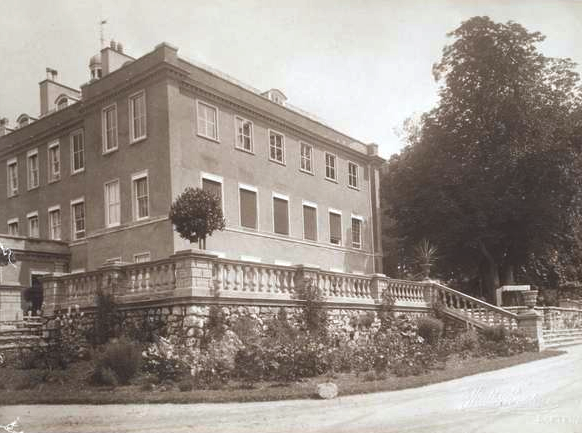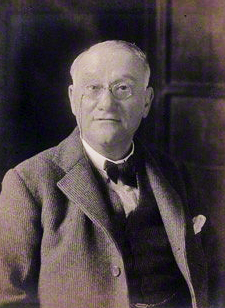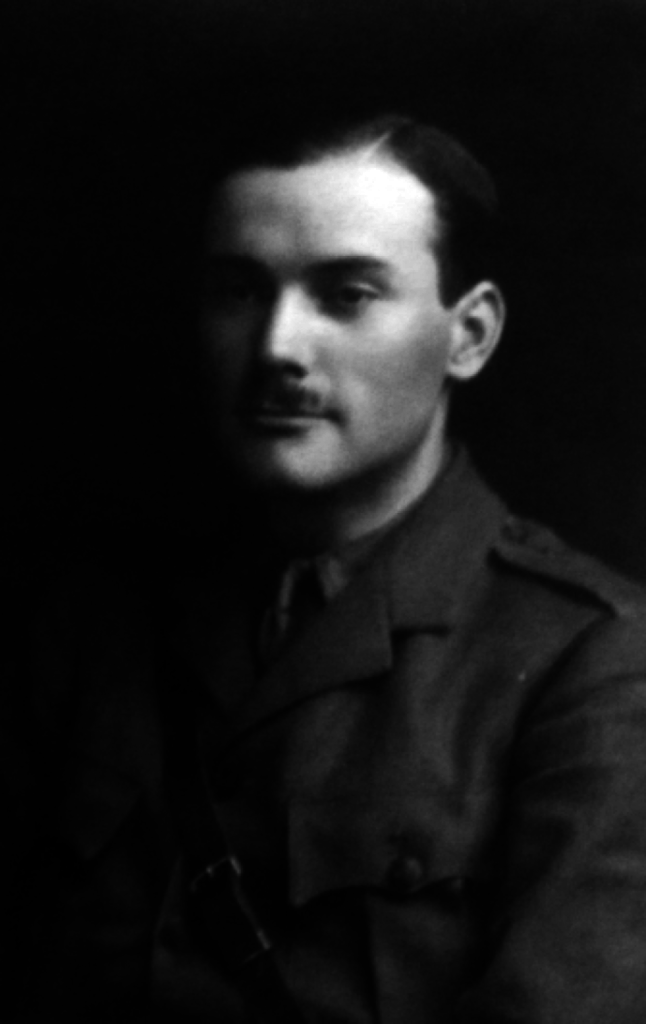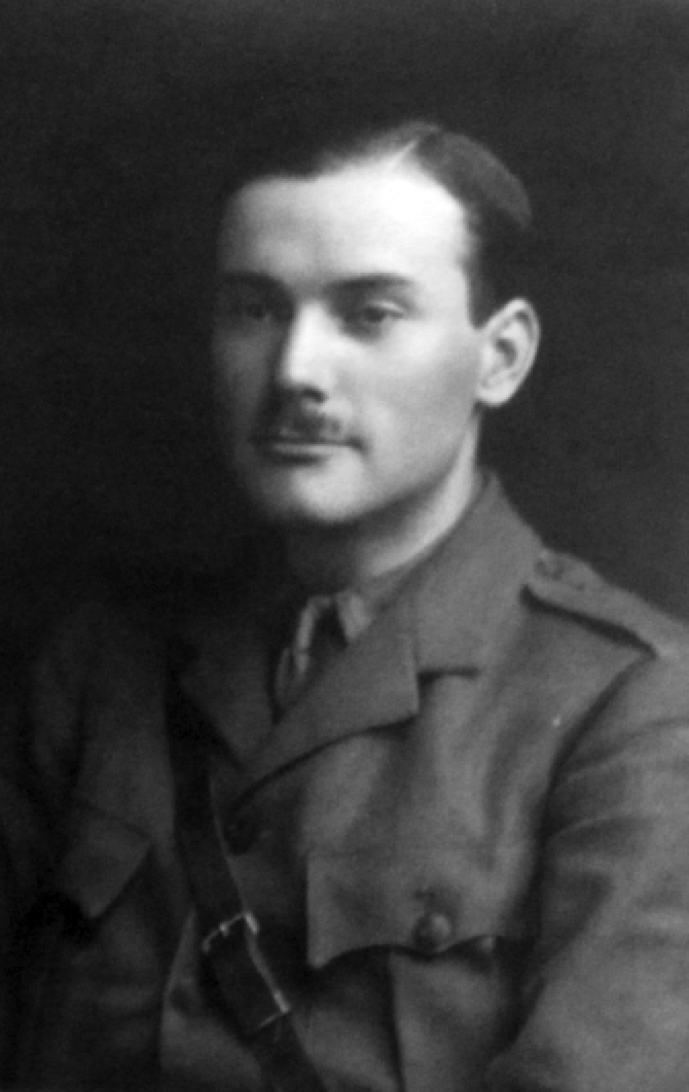Fact file:
Matriculated: 1911
Born: 5 December 1891
Died: 9 May 1915
Regiment: Rifle Brigade
Grave/Memorial: Ploegstreet Memorial: Panel 10
Family background
b. 5 December 1891 in Darjeeling, India, as the only son (of three children) of Sir Ernest Cable (1859–1927) and Lady Cable (née Lilian Sarah Sparkes) (1861–1937) (m. 1888), of “Lindridge”, Bishops Teignton, South Devon; 29, Hertford Street, Westminster, London W1; and 44, Grosvenor Square, London W1.

“Lindridge”, Bishops Teignton, South Devon (1915).
Parents and antecedents
Cable’s father was a highly successful self-made financier and industrialist who was born and grew up in India and made significant contributions to its industrial development in the nineteenth century. After studying at the University of Calcutta, Ernest Cable spent his entire professional life in agency houses that specialized in acquiring controlling interests in potentially profitable firms producing such raw materials as coal, copper, jute, lime, stone and timber. He was finally taken on by Bird & Co. (founded 1864) and made a junior partner in 1886 when only 27 (senior partner c.1900). By 1896, thanks in no small part to Cable’s entrepreneurial skills, financial shrewdness and ability to relate to Indians, Bird & Co. had expanded to become the direct or indirect employer of 30,000 people. His obituarist wrote: “He showed a singular prescience in recognizing paying propositions […] He also developed [Birds’s] activities in organizing labour corps for railway and other undertakings.” In 1896, the Company moved into investment banking and by 1908 it had formed three companies that either offered safe investment for expatriate British capital or financed new industrial ventures.
For two years (1903–05), Cable was President of the Bengal Chamber of Commerce and represented it on the Viceroy’s Legislative Council. He was Sheriff of Calcutta in 1905 and made a Knight of the Bath in 1906 by the Prince of Wales (cf. W.G.S. Cadogan). He was a powerful advocate of the need to invest, rather than hoard, wealth (as was the custom among wealthy Indians), and in a letter to The Times of 17 August 1908, he proposed setting up a committee of enquiry to investigate how Indians could be induced to invest their savings in state industrial enterprises. As a member of the Royal Commission on Indian Finance and Currency (1913–14), he strongly urged the creation of better banking facilities, and together with the economist John Maynard Keynes (1883–1964), he prepared a memorandum that was annexed to the Commission’s report and that proposed a State or Central Bank. The proposal bore fruit after the war when the three Presidency banks merged to become the Imperial Bank of India.

Ernest Cable (1859-1927), 1st Baron Cable
(Photograph NPG x67510 by Walter Stoneman (1921); © National Portrait Gallery, London)
By 1914 Ernest Cable was the senior partner in Bird & Co., but had moved to England, mainly South Devon and London, where he became a respected person in the county, a magistrate on the Tiverton Bench, and High Sheriff of Devon (1916); he was active in the recruitment and economy campaigns. His greatest coup came in 1917, when Bird & Co. acquired a controlling interest in F.W. Heilgers & Co., a prosperous Calcutta firm with interests in coal, jute and paper. The amalgamated company was the largest in India, with capital amounting to c.£20,000,000, revenue of c.£3,000,000 p.a., and 100,000 direct or indirect employees. Cable also served on the London Boards of the British America Assurance Co. and the Western Assurance Co., and was a Director of the Tanganyika Development Co. He was raised to the peerage on 17 January 1921, when he became the 1st (and only) Baron Cable of Ideford, Devon, a rare honour for a British businessman who had grown up in India, and on his death he left £214,715 (approximately £9,000,000 in 2005).
George Pickersgill’s paternal grandfather George Hebberd Cable (1823–73) was a warehouseman.
George’s mother was the daughter of a solicitor.
Siblings and their families
Brother of:
(1) The Honourable Noorouz Weston (c.1880–1969); later Alexander after her marriage in 1908 to Major Sir Lionel Cecil William Alexander, DSO (1896–1956), 6th Baronet Alexander of Belcamp, Co. Dublin (marriage dissolved in 1924); one son (the 7th Baronet, who had the surname Cable-Alexander). She then became Buller after her marriage in 1926 to Michael Francis Buller (1896–1975), a nephew of the controversial Second Boer War General Sir Redvers Buller, VC (1839–1908).
(2) Ruth McCarthy (b. 1895, probably in India, d. 1975); later Benthall after her marriage in 1918 to Edward (later Sir) Charles Benthall (1893–1961); one son.

Lady Alexander (Cable’s elder sister Noorouz) who worked in a Red Cross Hospital during World One. (Photo originally published in The Daily Mirror, no. 4,379 [6 November 1917], p. 5).
Lionel Cecil William Alexander served with the 23rd Battalion, London Regiment, attaining the rank of major, and was awarded the DSO in 1916. In 1929 he was High Sheriff of Cambridgeshire and Huntingdonshire.
Michael Francis Buller served in the Rifle Brigade.
Edward Charles Benthall became “perhaps the foremost figure in his day of the British mercantile community in India”. The son of a clergyman, he was a King’s Scholar at Eton and studied at King’s College, Cambridge. In 1913 he became an employee of the White Star Line and was in India when war broke out, but enlisted immediately and fought in Mesopotamia from 1916 to 1918, after which he worked for the War Office for a year. After the war he joined Bird & Co. in Calcutta and became a senior member of both this firm and F.W. Heilgers & Co. From 1926 to 1934 he was a Director of the Imperial Bank of India (Governor 1928–30, knighted 1933) and from 1935 to 1936 he was a Director of the Reserve Bank of India. During the 1930s he became Vice-President of the Bengal Chamber of Commerce (President in 1932 and 1936), a member of the Army Retrenchment Committee in 1931, and a member of India’s Upper House from 1932 to 1933. From 1933 to 1938 he was Vice-President of the Employers’ Federation of India. In 1938 he returned to England and was selected as Conservative candidate for the north-west division of Devon, but was prevented from standing by the outbreak of World War Two – during which he worked for three years in the Ministry of Economic Warfare and the Board of Trade. He returned to India in summer 1942 and became a member of the Governor-General’s Executive Council, where he was in charge of war transport and railways until 1946, when he became the Leader of the House in the Indian Assembly. After India’s independence he returned to Devon, where he served as the Vice-Chairman of the County River Board and followed his father-in-law by becoming High Sheriff of Devon in 1951. He also became a member of the governing body of the School of Oriental and African Studies, University of London, and was, from 1955 until 1960, a Governor of the BBC.
Education
Cable attended Western Grange Preparatory School, Bournemouth, Hampshire, from c.1898 to 1905, and then Harrow School from 1905 to 1911, where he was a Monitor from 1909 to 1911. He matriculated as a Commoner at Magdalen on 17 October 1911, having passed Responsions in Hilary Term 1911. He took the First Public Examinations in the Hilary Terms of 1912 and 1913, when he was awarded a high 2nd in Classical Moderations. He probably began to read for an Honours Degree in Classics, but left without taking a degree between Trinity Term and Michaelmas Term of 1914, presumably to join the Army. President Warren described him as having “excellent ability and no little taste and gift for scholarship” and as being “steadfast” and “a resolute worker”.

George Pickersgill Cable
(Photo courtesy of Magdalen College, Oxford).
“It is remarkable what an impression Cable made on his friends – of ability, goodness, sympathy, unselfishness. [He was] keen, cool, collected, a pleasant companion, and that fine type of English gentleman which has made England what she is.”
War service
Cable joined the Oxford University Officers’ Training Corps in his first term and served for three years. On 15 August 1914, shortly after leaving Oxford, he became a Second Lieutenant on probation in the 5th (Reserve) Battalion, the Rifle Brigade (The Prince Consort’s Own) (London Gazette, no. 28,876, 21 August 1914, p. 6,599), a unit which stayed on the Isle of Sheppey through the war as part of the Thames and Medway Garrison. On the outbreak of war, the 2nd (Regular) Battalion was stationed at Kuldana, a garrison town c.13 miles north-east of Islamabad in what is now Pakistan. It sailed from Bombay on 20 September 1914 and disembarked in Liverpool on 22 October, after which it trained at Hursley Park, Winchester, Hampshire, from 26 October to 4 November, i.e. while Cable was still attached to the 5th Battalion. But on 5 November the 2nd Battalion embarked at Southampton for France as part of 25th Brigade, 8th Division, IV (Indian) Corps, and arrived at Le Havre on the following day. By 17 November it was in the Laventie Salient, at Fauquissart, opposite the low but strategically important Aubers Ridge that ran north-southwards from Armentières to La Bassée via Aubers, Fromelles and Herlies and commanded the approaches to Lille. After spending January and February 1915 in the trenches, the 2nd Battalion took part in the Battle of Neuve Chapelle (10–13 March), the failed attempt to iron out the Laventie Salient and capture the Aubers Ridge (see M.A. Girdlestone), and suffered 261 casualties killed, wounded and missing.
Cable must have been transferred from the 5th to the 2nd Battalion of the Rifle Brigade as a replacement officer after this battle, for he disembarked in France on 17 March 1915 and probably joined the Battalion as one of a draft of six (unnamed) officers on 23 March when it was about to rest in billets at La Gorgue, about a mile west of Estaires. For the next six to seven weeks, the Battalion was in the trenches near Neuve Chapelle and either resting or in Reserve or preparing for the forthcoming battle nearby.
So on 9 May 1915 the Battalion was involved in a second attack on the Aubers Ridge between Aubers and Fromelles, part of the 2nd Battle of Artois (see also W.J.H. Curwen). The operation had been meticulously planned: 24th Brigade on the right was to take Deleval Farm and Rue Devel; 25th Brigade was to take Fromelles and secure the line from Fromelles to La Cordonnerie Farm; while 23rd Brigade plus a brigade from 7th Division was to push through the centre, take Aubers and Leclerq Farm, advance to La Plouich Farm and encircle the German positions by linking up with the left flank of the Meerut Division. But the assault across no-man’s-land, with Cable’s 2nd Battalion as one of the lead battalions in its centre opposite Fromelles, degenerated into chaos within an hour. Even before the 2nd Battalion went over the top, it suffered “severe casualties” when shells from its own supporting artillery fell short during the last ten minutes before zero hour. Then, while crossing 120 yards of no-man’s-land in the teeth of intense machine-gun fire, it took more heavy casualties, including nearly all its officers, even though it succeeded in capturing an 80-yard-long stretch of the German forward trench. Although it managed to extend that distance to 250 yards, the 2nd Battalion was unable to hold on to its gains, as the two brigades on the right and left had been forced to withdraw, exposing the remnants of Cable’s Battalion to enemy fire and bombing from three sides.
By 03.00 hours on 10 May, when it was decided to pull back, the men occupying the front trench had been all but wiped out and the Battalion had taken the heaviest number of casualties that it would suffer on any day of the war: 650 of its number, including Cable, aged 23, were killed, wounded and missing and only three officers and 195 other ranks (ORs) had survived unscathed. Although the Battalion War Diary never mentions Cable by name, his personal file tells us that after he had been wounded in the back, Private Potter, who was one of the 195 ORs to survive the attack, placed him in the advance trench “and left him there where he should have been safe”.
Cable has no known grave. He is commemorated on Panel 10 of the Ploegsteert Memorial. According to the Army List he was confirmed in the rank of Second Lieutenant on 9 June 1915, a month after his death. His Company Commander, Captain Nugent, who survived the war, later wrote to Cable’s parents:
All accounts agree that […] your son had done very good work here, and I considered him perhaps the ablest of all the young officers who have been through this Battalion. Some of the papers and reports that he sent in would have done credit to any Officer.
Cable’s Commanding Officer, Lieutenant-Colonel Talbot, who also survived the war, echoed those sentiments, adding that Cable was “keen, cool, collected, a pleasant companion, and that fine type of English Gentleman which has made England what she is”. On 27 May 1915 C.C.J. Webb noted in his Diary:
Cookson [Magdalen’s Senior Tutor before the war] sent me a wonderfully touching letter from [G.T.L.] Ellwood about Cable. It is remarkable what an impression Cable made on his friends – of ability, goodness, sympathy, unselfishness. He was difficult to make talk when he came with an essay: so that I did not know him as well as I wished.
Bibliography
For the books and archives referred to here in short form, refer to the Slow Dusk Bibliography and Archival Sources.
Printed sources:
[Thomas Herbert Warren]. ‘Oxford’s Sacrifice’ [obituary], The Oxford Magazine, 33, no. 20 (21 May 1915), p. 320.
Harrow Memorials, ii (1918), unpaginated.
[Anon.], ‘Lord Cable: Business Career in India’ [obituary], The Times, no. 44,542 (29 March 1927), p. 19.
Berkeley and Seymour, i (1927), pp. 37–41, 48–63, 70–5, 95–106.
[Anon.], ‘Sir Lionel Alexander’ [obituary], The Times, no. 53,604 (8 August 1956), p. 11.
[Anon.], ‘Sir Edward Benthall’ [obituary], The Times, no. 55,023 (7 March 1961), p. 15.
S.D. Chapman, ‘Cable, Ernest, Baron Cable (1859–1927)’, Oxford Dictionary of National Biography, vol. 9 (2004), pp. 379–80.
Hancock (2005), pp. 87 and 97–109.
Archival sources:
MCA: Ms. 876 (III), vol. 1.
MCA: PR/2/18 (President’s Notebooks [1913]), p. 214.
OUA: UR 2/1/74.
OUA (DWM): C.C.J. Webb, Diaries, MS. Eng. misc. d. 1160.
WO95/1731.
WO339/29964.
